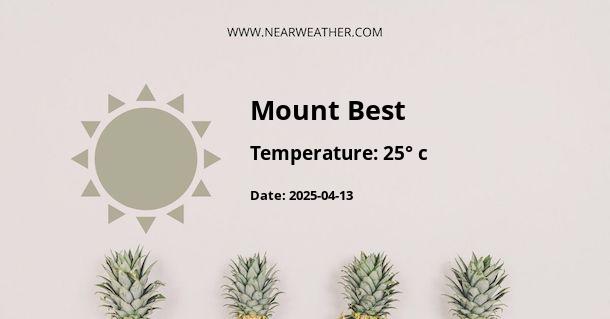Climate and Weather in Mount Best, Australia
Located in the state of Victoria, Mount Best is a picturesque town known for its stunning natural beauty and diverse climate. The region experiences a unique blend of coastal and mountain weather patterns, resulting in a climate that is characterized by mild temperatures, moderate rainfall, and occasional extreme weather events. In this article, we will explore the climate and weather conditions in Mount Best throughout the year.
Temperature
The temperature in Mount Best varies significantly throughout the year, with distinct seasons showcasing different weather patterns. Summers in Mount Best are generally warm, with average temperatures ranging from 20 to 25 degrees Celsius (68 to 77 degrees Fahrenheit). The hottest months are typically January and February, with temperatures occasionally reaching as high as 30 degrees Celsius (86 degrees Fahrenheit).
Winters in Mount Best are relatively cool, with average temperatures ranging from 10 to 15 degrees Celsius (50 to 59 degrees Fahrenheit). The coldest months are usually June and July, when temperatures can drop to as low as 5 degrees Celsius (41 degrees Fahrenheit) during the night. It is important to note that Mount Best is located in a higher elevation, which means that temperatures can be slightly cooler than surrounding areas.
Rainfall
Mount Best receives a moderate amount of rainfall throughout the year, with most of the precipitation occurring during the cooler months. The average annual rainfall in the region is around 900 millimeters (35 inches). The wettest months are typically between May and September, with July being the rainiest month.
During the summer months, rainfall is generally lower, with occasional thunderstorms bringing short bursts of heavy rain. The autumn and spring seasons experience more balanced rainfall patterns, making them ideal times to explore the natural beauty of Mount Best.
Extreme Weather Events
While Mount Best generally experiences mild and pleasant weather, the region is occasionally affected by extreme weather events. The area is prone to bushfires, especially during the hot and dry summer months. It is important for residents and visitors to stay informed about fire danger ratings and follow local fire safety guidelines.
Mount Best is also susceptible to strong winds, particularly during the winter months. These winds can bring cooler temperatures and occasionally disrupt outdoor activities. It is advisable to check weather forecasts and dress appropriately when visiting the area during these times.
Climate Overview
The climate in Mount Best can be classified as a temperate oceanic climate, influenced by both coastal and mountain weather patterns. The region experiences mild temperatures, moderate rainfall, and occasional extreme weather events. The diverse climate makes Mount Best an attractive destination for outdoor enthusiasts, offering a range of activities such as hiking, fishing, and wildlife spotting.
Climate Data for Mount Best:
| Month | Average Temperature (°C) | Average Rainfall (mm) |
|---|---|---|
| January | 22 | 40 |
| February | 23 | 45 |
| March | 20 | 50 |
| April | 17 | 60 |
| May | 14 | 80 |
| June | 11 | 100 |
| July | 10 | 120 |
| August | 11 | 110 |
| September | 13 | 90 |
| October | 16 | 80 |
| November | 18 | 60 |
| December | 21 | 50 |
Conclusion
Mount Best, Australia, offers a unique climate characterized by mild temperatures, moderate rainfall, and occasional extreme weather events. With its diverse weather patterns, the region provides a range of outdoor activities and stunning natural beauty to explore throughout the year. Whether you are a nature enthusiast, hiker, or simply seeking a tranquil getaway, Mount Best is sure to captivate and inspire.
A - Mount Best's Latitude is -38.599998 & Longitude is 146.300003.
A - Weather in Mount Best is 25° today.
A - Climate Conditions in Mount Best shows broken clouds today.
A - Humidity in Mount Best is 34% today.
A - Wind speed in Mount Best is 13.18 km/h, flowing at 315° wind direction. today.
